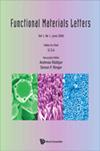碱性脱除天然高岭土合成二维A型分子筛
IF 1.1
4区 材料科学
Q4 MATERIALS SCIENCE, MULTIDISCIPLINARY
引用次数: 0
摘要
A型分子筛广泛应用于各个领域。值得注意的是,以天然高岭土为原料直接合成A型分子筛是研究人员普遍采用的做法。传统的A型分子筛具有三维立方晶格结构。在本研究中,我们的目标是通过采用二维层状材料作为模板剂,促进A型分子筛向二维层状结构的转化。本研究以天然高岭土为主要原料。为了去除杂质,包括石英、伊利石和白云石,采用碱基溶剂萃取法,得到非晶硅和铝化合物。随后,介绍了石墨烯基模板剂,并采用水热合成工艺制备了二维a型分子筛。本文所述的方法产生结晶度超过90%的二维层状A型分子筛,从而产生比表面积比其三维A型分子筛大约11倍。这种方法的适用性可以扩展到低品位天然矿产资源的价值评估,以优化其效用。此外,本文提出的二维分子筛的合成方法具有普遍性,为其他各种二维分子筛的合成提供了有价值的见解。本文章由计算机程序翻译,如有差异,请以英文原文为准。
Synthesis of 2-D Type A molecular sieves by alkaline removal of natural kaolin
Type A molecular sieves have been extensively employed in various fields. It is noteworthy that the direct synthesis of type A molecular sieves from natural kaolin is a common practice among researchers. Traditional type A molecular sieves are characterized by a three-dimensional cubic lattice structure. In this study, our objective is to facilitate the transformation of type A molecular sieves into a two-dimensional layered configuration by employing a two-dimensional layered material as a templating agent. In this research, natural kaolin serves as the primary source material. To eliminate impurities including quartz, illite, and dolomite, an alkali-based solvent extraction method is employed, yielding amorphous silicon and aluminum compounds. Subsequently, a graphene-based templating agent is introduced, and a hydrothermal synthesis process is employed to fabricate two-dimensional type A molecular sieves. The method described herein yields two-dimensional layered type A molecular sieves with a crystallinity exceeding 90%, thereby resulting in a specific surface area that is approximately 11-fold greater compared to their three-dimensional type A counterparts. The applicability of this methodology can be extended to the valorization of low-grade natural mineral resources, optimizing their utility. Furthermore, the approach presented herein for the synthesis of two-dimensional molecular sieves is of a universal nature, offering valuable insights that can serve as a reference for the synthesis of various other categories of two-dimensional molecular sieves.
求助全文
通过发布文献求助,成功后即可免费获取论文全文。
去求助
来源期刊

Functional Materials Letters
工程技术-材料科学:综合
CiteScore
2.40
自引率
7.70%
发文量
57
审稿时长
1.9 months
期刊介绍:
Functional Materials Letters is an international peer-reviewed scientific journal for original contributions to research on the synthesis, behavior and characterization of functional materials. The journal seeks to provide a rapid forum for the communication of novel research of high quality and with an interdisciplinary flavor. The journal is an ideal forum for communication amongst materials scientists and engineers, chemists and chemical engineers, and physicists in the dynamic fields associated with functional materials.
Functional materials are designed to make use of their natural or engineered functionalities to respond to changes in electrical and magnetic fields, physical and chemical environment, etc. These design considerations are fundamentally different to those relevant for structural materials and are the focus of this journal. Functional materials play an increasingly important role in the development of the field of materials science and engineering.
The scope of the journal covers theoretical and experimental studies of functional materials, characterization and new applications-related research on functional materials in macro-, micro- and nano-scale science and engineering. Among the topics covered are ferroelectric, multiferroic, ferromagnetic, magneto-optical, optoelectric, thermoelectric, energy conversion and energy storage, sustainable energy and shape memory materials.
 求助内容:
求助内容: 应助结果提醒方式:
应助结果提醒方式:


